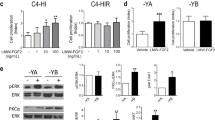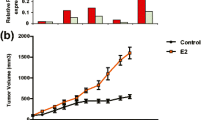Summary
Progesterone in hormone replacement therapy (HRT) preparations increases, while hysterectomy greatly reduces, the incidence of breast cancer. Cross-talk between the progesterone and growth factor signaling pathways occurs at multiple levels and this maybe a key factor in breast cancer survival and progression. To test this hypothesis, we characterized the effect of progesterone pre-treatment on the sensitization of the epidermal growth factor (EGF) signaling pathway to EGF in the breast cancer cell line ZR-75. For the first time in ZR-75 cells and in agreement with previous work using synthetic progestins, we demonstrate that pre-treatment with the natural ligand progesterone increases EGF receptor (EGFR) levels and subsequent ligand-dependent phosphorylation. Downstream we demonstrate that progesterone alone increases erk-1 + 2 phosphorylation, potentiates EGF-phosphorylated erk-1 + 2 and maintains these levels elevated for 24 h; over 20 h longer than in vehicle treated cells. Additionally, progesterone increased the levels of STAT5, another component of the EGF signaling cascade. Progesterone increased EGF mediated transcription of a c-fos promoter reporter and the nuclear localization of the native c-fos protein. Furthermore, progesterone and EGF both alone and in combination, significantly increase cell proliferation. Several results presented herein demonstrate the conformity between the action of the natural ligand progesterone with that of synthetic progestins such as MPA and R5020 and allows the postulation that the progestin/progesterone-dependent increase of EGF signaling provides a survival advantage to burgeoning cancer cells and may contribute to the breast cancer risk associated with endogenous progesterone and with progestin-containing HRT.
Similar content being viewed by others
Abbreviations
- C:
-
vehicle control
- EGF:
-
epidermal growth factor
- EGFR:
-
EGF receptor
- ER:
-
estrogen receptor
- hours:
-
h
- HRT:
-
hormone replacement therapy
- minutes:
-
min
- P4:
-
Progesterone
- PR:
-
progesterone receptor
- STAT:
-
signal transducers and activators of transcription
References
D Graham C Clarke (1997) ArticleTitlePhysiological action of progesterone in target tissues Endocrine Rev 18 502–519 Occurrence Handle10.1210/er.18.4.502
OM Conneely DM Kettelberger MJ Tsai WT Schrader BW O’Malley (1989) ArticleTitleThe chicken progesterone receptor A and B isoforms are products of an alternate translation initiation event J Biol Chem 264 14062–14064 Occurrence Handle2760059
DL Bain MA Franden JL McManaman GS Takimoto KB Horwitz (2001) ArticleTitleThe N -terminal region of human progesterone B-receptors: biophysical and biochemical comparison to A-receptors J Biol Chem. 276 23825–23831 Occurrence Handle10.1074/jbc.M102611200 Occurrence Handle11328821
JP Lydon FJ DeMayo CR Funk SK Mani AR Hughes CA Montgomery SuffixJr G Shyamala OM Conneely BW O’Malley (1995) ArticleTitleMice lacking progesterone receptor exhibit pleiotropic reproductive abnormalities Genes Dev 9 2266–2278 Occurrence Handle7557380
G Beatson (1896) ArticleTitleOn the treatment of inoperable cases of carcinoma of the mamma: suggestions for a new method of treatment will illustrative cases Lancet ii 104–107
I Peerson E Wliderpass L Bergkrist R Bergtrom C Schairer (1999) ArticleTitleRisk of breast and endometrial cancer after estradiol and estradiol-progestine replacement Cancer Causes Control 10 253–260 Occurrence Handle10.1023/A:1008909128110 Occurrence Handle10482483
C Schairer J Lubin R Troisi S Sturgeon L Brinton R Hoover (2000) ArticleTitleMenopausal estrogen and estrogen-progestin replacement therapy and breast cancer risk JAMA 283 485–491 Occurrence Handle10.1001/jama.283.4.485 Occurrence Handle10659874
RT Chlebowski SL Hendrix RD Langer ML Stefanick M Gass D Lane RJ Rodabough MA Gilligan MG Cyr CA Thomson J Khandekar H Petrovitch A McTiernan InstitutionalAuthorNameWHI Investigators (2003) ArticleTitleInfluence of estrogen plus progestin on breast cancer and mammography in healthy postmenopausal women: the Women’s Health Initiative Randomized Trial JAMA 289 3243–3253 Occurrence Handle10.1001/jama.289.24.3243 Occurrence Handle12824205
TJ Key PK Verkasalo E Banks (2001) ArticleTitleEpidemiology of breast cancer Lancet Oncol 2 133–140 Occurrence Handle10.1016/S1470-2045(00)00254-0 Occurrence Handle11902563
W Catherino M Jeng V Jordan (1993) ArticleTitleNorgestrel and gestodene stimulate breast cancer cell growth through an oestrogen receptor mediated mechanism Br J Cancer 67 945–952 Occurrence Handle8494728
PJ Weiler JP Wiebe (2000) ArticleTitlePlasma membrane receptors for the cancer-regulating progesterone metabolites, 5alpha-pregnane-3,20-dione and 3alpha-hydroxy-4-pregnen-20-one in MCF-7 breast cancer cells Biochem Biophys Res Commun 272 731–737 Occurrence Handle10.1006/bbrc.2000.2847 Occurrence Handle10860824
M Montecchia C Lamb A Molinolo I Luthy P Pazos E Charreau S Vanzulli C Lanari (1999) ArticleTitleProgesterone receptor involvement in independent tumor growth in MPA-induced murine mammary adenocarcinomas J Steroid Biochem Mol Biol 68 11–21 Occurrence Handle10.1016/S0960-0760(98)00166-6 Occurrence Handle10215033
J Wiesen P Young G Werb G Cunha (1999) ArticleTitleSignaling through the stromal epidermal growth factor receptor is necessary for mammary ductal development Development 126 335–344 Occurrence Handle9847247
PJ Miettinen JE Berger J Meneses Y Phung RA Pedersen Z Werb R Derynck (1995) ArticleTitleEpithelial immaturity and multiorgan failure in mice lacking epidermal growth factor receptor Nature 376 337–341 Occurrence Handle10.1038/376337a0 Occurrence Handle7630400
R Jorissen F Walker N Pouliot T Garrett C Ward A Burgess (2003) ArticleTitleEpidermal growth factor receptor: mechanisms of activation and signaling Exp Cell Res 284 31–53 Occurrence Handle10.1016/S0014-4827(02)00098-8 Occurrence Handle12648464
SB Fox AL Harris (1997) ArticleTitleThe epidermal growth factor receptor in breast cancer J Mammary Gland Biol Neoplasia 2 131–141 Occurrence Handle10.1023/A:1026399613946 Occurrence Handle10882299
N Normanno F Ciardiello (1997) ArticleTitleEGF-related peptides in the pathophysiology of the mammary gland J Mammary Gland Biol Neoplasia 2 143–151 Occurrence Handle10.1023/A:1026351730785 Occurrence Handle10882300
PM Navolanic LS Steelman JA McCubrey (2003) ArticleTitleEGFR family signaling and its association with breast cancer development and resistance to chemotherapy (Review) Int J Oncol 22 237–252 Occurrence Handle12527919
S Groshong G Owen B Grimison I Schauer M Todd T Langan R Sclafani C Lange K Horwitz (1997) ArticleTitleBiphasic regulation of breast cancer cell growth by progesterone: role of the cyclin-dependent kinase inhibitors, p21 and p27(Kip1) Mol Endocrinol 11 1593–1607 Occurrence Handle10.1210/me.11.11.1593 Occurrence Handle9328342
J Richer N Lange N Manning G Owen R Powell K Horwitz (1998) ArticleTitleConvergence of progesterone with growth factor and cytokine signaling in breast cancer J Biol Chem 273 31317–31326 Occurrence Handle10.1074/jbc.273.47.31317 Occurrence Handle9813040
CA Lange JK Richer KB Horwitz (1999) ArticleTitleHypothesis: progesterone primes breast cancer cells for cross-talk with proliferative or antiproliferative signals Mol Endocrinol 13 829–836 Occurrence Handle10.1210/me.13.6.829 Occurrence Handle10379882
C Lange J Richer T Shen K Horwitz (1998) ArticleTitleConvergence of progesterone and epidermal growth factor signaling in breast cancer J Biol Chem 273 31308–31316 Occurrence Handle10.1074/jbc.273.47.31308 Occurrence Handle9813039
C Lange (2004) ArticleTitleMaking sense of cross-talk between steroid hormone receptors and intracellular signaling pathways: who will have the last word? Mol Endocrinol 18 269–278 Occurrence Handle10.1210/me.2003-0331 Occurrence Handle14563938
LC Murphy LJ Murphy D Dubik GI Bell RP Shiu (1998) ArticleTitleEpidermal growth factor gene expression in human breast cancer cells: regulation of expression by progestins Cancer Res 48 4555–4560
HS Earp TL Dawson X Li H Yu (1995) ArticleTitleHeterodimerization and functional interaction between EGF receptor family members: a new signalling paradigm with implications for breast cancer research Breast Cancer Res Treat 35 115–132 Occurrence Handle10.1007/BF00694752 Occurrence Handle7612898
S Menard M Fortis F Castiglioni R Agresti A Balsari (2001) ArticleTitleHER2 as a prognostic factor in breast cancer Oncology 61 67–72 Occurrence Handle10.1159/000055404 Occurrence Handle11694790
R Santen R Song R McPherson R Kumar L Adam M Jeng W Yue (2002) ArticleTitleThe role of mitogen-activated protein (MAP) kinase in breast cancer J Steoid Biochem Mol Biol 80 239–256 Occurrence Handle10.1016/S0960-0760(01)00189-3
CA Sartorius SD Groshong LA Miller RL Powell L Tung GS Takimoto KB Horwitz (1994) ArticleTitleNew T47D breast cancer cell lines for the independent study of progesterone B- and A-receptors: only antiprogestin-occupied B-receptors are switched to transcriptional agonists by cAMP Cancer Res 54 3868–3877 Occurrence Handle8033109
V Calò M Migliavacca V Bazan M Macaluso M Buscemi N Gebbia A Russo (2003) ArticleTitleSTAT proteins: from normal control of cellular events to tumorigenesis J Cell Physiol 197 157–168 Occurrence Handle10.1002/jcp.10364 Occurrence Handle14502555
L Hennighausen GW Robinson KU Wagner XJ Liu (1997) ArticleTitleDeveloping a mammary gland is a STAT affair Mammary Gland Biol Neoplasia. 2 365–372 Occurrence Handle10.1023/A:1026347313096
JA Philp TG Burdon CJ Watson (1996) ArticleTitleDifferential activation of STATs 3 and 5 during mammary gland development FEBS Lett 396 77–80 Occurrence Handle10.1016/0014-5793(96)01069-1 Occurrence Handle8906870
E Iavnilovitch B Groner I Barash (2002) ArticleTitleOverexpression and forced activation of STAT5 in mammary gland of transgenic mice promotes cellular proliferation, enhances differentiation, and delays postlactational apoptosis Mol Cancer Res 1 32–47 Occurrence Handle12496367
J Richer B Jacobsen N Manning G Abel D Wolf K Horwitz (2002) ArticleTitleDifferential gene regulation by the two progesterone receptor isoforms un human breast cancer cells J Biol Chem 277 5209–5218 Occurrence Handle10.1074/jbc.M110090200 Occurrence Handle11717311
CS Hill R Treisman (1995) ArticleTitleDifferential activation of c-fos promoter elements by serum, lysophosphatidic acid, G proteins and polypeptide growth factors EMBO J 14 5037–5047 Occurrence Handle7588632
DW Kim V Cheriyath AL Roy BH Cochran (1998) ArticleTitleTFII-I enhances activation of the c-fos promoter through interactions withupstream elements Mol Cell Biol 18 3310–3320 Occurrence Handle9584171
K Milde-Langosch H Roder B Andritzky B Aslan G Hemminger A Brinkmann CM Bamberger T Loning AM Bamberger (2004) ArticleTitleThe role of the AP-1 transcription factors c-Fos, FosB, Fra-1 and Fra-2 in the invasion process of mammary carcinomas Breast Cancer Res Treat 86 139–152 Occurrence Handle10.1023/B:BREA.0000032982.49024.71 Occurrence Handle15319566
EA Musgrove CS Lee RL Sutherland (1991) ArticleTitleProgestins both stimulate and inhibit breast cancer cell cycle progression while increasing expression of transforming growth factor alpha, epidermal growth factor receptor, c-fos, and c-myc genes Mol Cell Biol 11 5032–5043 Occurrence Handle1922031
LW Engel NA Young TS Tralka ME Lippman SJ O’Brien MJ Joyce (1978) ArticleTitleEstablishment and characterization of three new continuous cell lines derived from human breast carcinomas Cancer Res 38 3352–3364 Occurrence Handle688225
G Owen J Richer L Tung G Takimoto K Horwitz (1998) ArticleTitleProgesterone regulates transcription of the p21WAF1 cyclin-dependent kinase inhibitor gene through Sp1 and CBP/p300 J Biol Chem 273 10696–10701 Occurrence Handle10.1074/jbc.273.17.10696 Occurrence Handle9553133
L Murphy R Sutherland B Stead LC Murphy L Lazarus (1986) ArticleTitleProgestin regulation of epidermal growth factor receptor in human mammary carcinoma cells Cancer Res 46 728–734 Occurrence Handle3000583
MA Wilson SA Chrysogelos (2002) ArticleTitleIdentification and characterization of a negative regulatory element within the epidermal growth factor receptor gene first intron in hormone-dependent breast cancer cells J Cell Biochem 85 601–614 Occurrence Handle10.1002/jcb.10168 Occurrence Handle11968000
T Holbro G Civenni N Hynes (2003) ArticleTitleThe ErbB receptors and their role in cancer progression Exp Cell Res 284 99–110 Occurrence Handle10.1016/S0014-4827(02)00099-X Occurrence Handle12648469
HS Wiley (2003) ArticleTitleTrafficking of the ErbB receptors and its influence on signaling Exp Cell Res 284 78–88 Occurrence Handle10.1016/S0014-4827(03)00002-8 Occurrence Handle12648467
K McBride G Banninger C McDonald N Reich (2002) ArticleTitleRegulated nuclear import of the STAT1 transcription factor by direct binding of importin-α EMBO J 21 1754–1763 Occurrence Handle10.1093/emboj/21.7.1754 Occurrence Handle11927559
E Stocklin M Wissler F Gouilleux B Groner (1996) ArticleTitleFunctional interactions between Stat5 and the glucocorticoid receptor Nature 383 726–728 Occurrence Handle10.1038/383726a0 Occurrence Handle8878484
L Björnström E Kilic M Norman M Parker M Sjoberg (2001) ArticleTitleCross-talk between STAT5b and estrogen receptor-α and -β in mammary epithelial cells J Mol Endocrinol 27 93–106 Occurrence Handle10.1677/jme.0.0270093 Occurrence Handle11463580
H Pang BG Rowan M Al-Dhaheri LE Faber (2004) ArticleTitleEpidermal growth factor suppresses induction by progestin of the adhesion protein desmoplakin in T47D breast cancer cells Breast Cancer Res 6 R239–R245 Occurrence Handle10.1186/bcr780 Occurrence Handle15084247
Author information
Authors and Affiliations
Corresponding author
Additional information
*This work was supported by the National Chilean Fund for the Development of Science and Technology (FONDECYT 1020715) and a Wellcome Trust International collaboration grant GR071469.
Rights and permissions
About this article
Cite this article
Carvajal, A., Espinoza, N., Kato, S. et al. Progesterone Pre-treatment Potentiates EGF Pathway Signaling in The Breast Cancer Cell Line ZR-75*. Breast Cancer Res Treat 94, 171–183 (2005). https://doi.org/10.1007/s10549-005-7726-6
Issue Date:
DOI: https://doi.org/10.1007/s10549-005-7726-6




